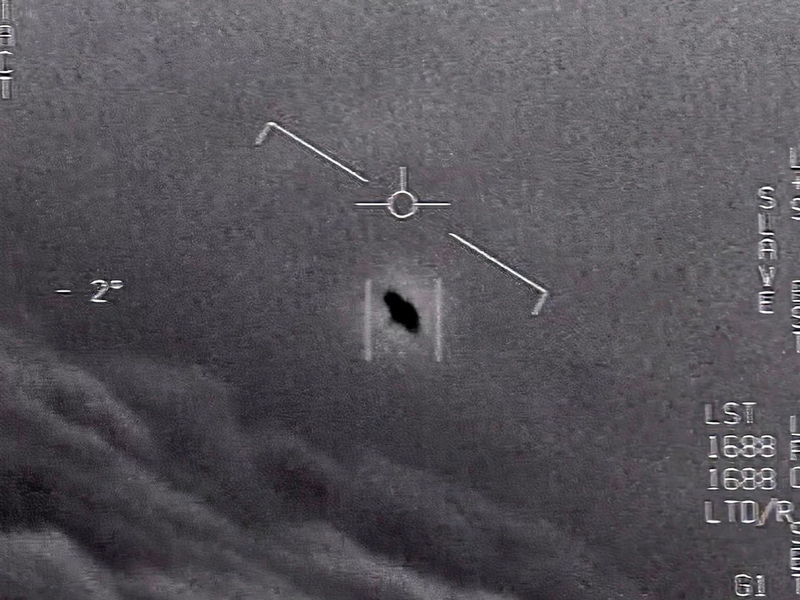
A NASA research panel has been looking into reported sightings of airborne phenomena “that cannot be identified as aircraft or known natural phenomena from a scientific perspective.” It is expected to release a report in July.
Addressing the group’s first public meeting, which included a live broadcast online, panelist Sean Kirkpatrick, director of the U.S. Defense Department’s All-domain Anomaly Resolution Office, said authorities receive 50-100 UFO reports a month. Only two to five per cent are “possibly really anomalous.”
The grassroots organization Ufology Research has collected and analyzed Canadian UFO reports since 1989. Its 2017 survey found 1,101 reported sightings across the country, a rate of roughly three a day. And that was only the fifth highest number it had recorded. Numbers have been on the decline since. Outcomes are less clear.
Why Canada, with a tenth the population, has such a high rate of reported UFO sightings may be attributable to several factors, including the fact that Canada has more dark skies than the U.S., the northern lights are closer and more visible here, and Canadians tend to be more trusting of government than their American cousins and therefore more likely to report what they see.
Besides, suggests my editor, if you were an alien, wouldn’t you rather come to Canada than the United States?
In March 2023, the Canadian government’s top scientist launched a study into unidentified anomalous phenomena. The Sky Canada Project is being conducted by the Office of the Chief Science Advisor of Canada. It is the first known official Canadian UFO research effort in nearly 30 years.
The study is looking at how UAP reports are handled in Canada and will make recommendations for needed improvements. A final public report is expected in early 2024.

The panelists acknowledged that UFO sightings are under-reported, especially by those best in a position to encounter strange phenomena in the skies.
The American military, with its Space Force and its own investigative bodies, seems more concerned with UFOs’ implications for security and defence than Canada.
The Pentagon reported in 2021 that only one of 144 sightings by military pilots since 2004 remained unexplained.
Authorities have not ruled out the possibility that unexplained objects are extraterrestrial. Still, some of the explanations for what people thought they had seen illustrate how easily people’s eyes can be deceived.
The NASA panel chair, David Spergel, described how researchers in Australia picked up a confounding burst of radio waves. “They had really strange structure. People couldn’t figure out what was going on. Then they start to notice a lot of them bunched together around lunch time.”
It turned out the Aussies’ ultra-sensitive instruments were picking up signals from the microwave oven the researchers were using to heat up their lunches.
Veteran astronaut and naval aviator Scott Kelly told the public meeting how he was flying near Virginia Beach when his co-pilot was “convinced we flew by a UFO.”
“I didn’t see it,” said Kelly, who logged 520 days in space over four trips to the International Space Station, including a 340-day mission that ended in March 2016.
“We turned around, we went to look at it; it turns out it was Bart Simpson. A balloon.”
The panelists acknowledged that UFO sightings are under-reported, especially by those best in a position to encounter strange phenomena in the skies.
Commercial pilots can be especially reluctant to report sightings due to stigma surrounding flying saucers, Spergel said. Some scientists have even been harassed online for their work in the field.
“One of our goals is to remove the stigma because there is a need for high-quality data to address important questions about UAPs,” he explained.
Added NASA science chief Nicola Fox: “Harassment only leads to further stigmatization of the UAP field, significantly hindering the scientific process and discouraging others to study this important subject matter.”
There is even evidence that Earth’s nearest planetary neighbour, Mars, could once have supported some form of life.
After decades in which UFOs were frequently dismissed from sensible scientific discussion, NASA now wants to take the subject seriously.
The fact the public forum even took place reflects a continuing shift across the wider scientific community “regarding the willingness to talk openly and honestly about the potential for extraterrestrial life in the universe,” noted BBC science editor Richard Gray.
“Many scientists often avoided being drawn into such discussions,” Gray wrote. “But it is now largely accepted that alien life probably does exist somewhere out there.
“Data beamed back from other worlds within our solar system have revealed they have environments that could well be capable of supporting primitive life, such as within the icy oceans of the moons of Jupiter and Saturn.”
Potential building blocks of life in the form of organic compounds have been found on asteroids and comets. There is even evidence that Earth’s nearest planetary neighbour, Mars, could once have supported some form of life.
Spergel told the forum that the possibility of extraterrestrial life is one of NASA’s big questions.
“We now know that there are lots of planets out there, so there are lots of potential environments for life,” and the space agency is taking multiple strategies to address the issue. “We haven’t found life beyond Earth yet, but we’re looking.”
One of NASA’s earliest endeavours down that path, the Voyager 1 space probe, was launched in 1977. It had travelled 23.816 billion kilometres by May 17, 2023. It carries a copy of the Golden Record—a message from humanity to the cosmos that includes greetings in 55 languages, pictures of people and places on Earth and music ranging from Beethoven to Chuck Berry’s “Johnny B. Goode.”
The independent search for extraterrestrial intelligence, or SETI, includes a branch known as the communication with extraterrestrial intelligence, or CETI, that focuses on composing and deciphering interstellar messages that theoretically could be understood by another technological civilization.
Its best-known experiment was the 1974 Arecibo message composed by Frank Drake, an American astrophysicist and astrobiologist. The interstellar radio message bearing basic information about Earth and humanity was sent to the globular cluster Messier 13, which is composed of several hundred thousand stars in the Hercules constellation.
“Are there other planet Earths out there? I certainly think so.”
Nikola Tesla thought inventions such as his Tesla coil could be used to communicate with other planets. He had observed repetitive signals of what he believed were extraterrestrial radio communications coming from Venus or Mars in 1899. They turned out to be terrestrial radiation.
A 2021 Ipsos poll indicated two in three Canadians—65 per cent—believed intelligent life exists beyond Earth; 56 per cent said they believed in UFOs. The alien life numbers are identical south of the border, but a Pew Research Center survey found far fewer American respondents to its 2021 survey—40 per cent—said they believed UFOs are alien in origin.
NASA head Bill Nelson said in 2021 that he “certainly” thinks there is alien life elsewhere in the universe.
“My personal opinion is that the universe is so big and, now, there are even theories that there might be other universes,” Nelson told a University of Virginia forum, in Charlottesville, Va. “If that’s the case, who am I to say that planet Earth is the only location of a life form that is civilized and organized like ours?
“Are there other planet Earths out there? I certainly think so.”
Indeed, NASA has confirmed the existence of more than 5,000 exoplanets—planets orbiting stars outside the solar system, some of them in the so-called “sweet spot,” or at a distance from their sun considered habitable with the requisite liquid water, energy and nutrients believed necessary to sustain life.
As of June 2021, 59 potentially habitable exoplanets had been found, the nearest 12 light-years away, or 12 times the distance light travels in one Earth year.
NASA’s former chief scientist, Ellen Stofan, predicted in 2015 that scientists would find evidence of alien life by 2025.
“I’m going to say we are going to have strong indications of life beyond Earth within a decade and I think we are going to have definitive evidence within 20 to 30 years,” said Stofan, who’s now under-secretary for science and research at the Smithsonian Institution. “We know where to look. We know how to look.
“In most cases, we have the technology and we are on the path to implementing it. So, I think we are on the road.”
“If aliens visit us, the outcome would be much as when Columbus landed in America, which didn’t turn out well for the Native Americans.”
Jeff Newmark, at the time NASA’s interim director of heliophysics—the study of the physics of the sun and its connection to the solar system—predicted it was a matter of “when, not if” life beyond Earth is discovered.
If there is intelligent life out there, some say bringing its attention to us may not be the best idea. In fact, the late British astrophysicist Stephen Hawking declared it an absolutely bad one.
Hawking, considered one of the great minds of the 20th century, said it is likely that intelligent life exists beyond Earth, but he likened a visit from extraterrestrials to the arrival of Christopher Columbus in the Americas (it has since been discovered that Vikings arrived in Newfoundland 500 years before Columbus crossed the ocean).
“If aliens visit us, the outcome would be much as when Columbus landed in America, which didn’t turn out well for the Native Americans,” he warned.
“We only have to look at ourselves to see how intelligent life might develop into something we wouldn’t want to meet.”
He suggested alien capabilities “would be only limited by how much power they could harness and control, and that could be far more than we might first imagine.”
One of the reasons for the May 31 forum was to dispel any notion, long held by some skeptics and conspiracy theorists, that authorities know more than they are letting on.
A NASA public affairs officer read out questions from the public: “What is NASA hiding? How much has been shared publicly? Has NASA ever cut the live NASA TV feeds away from something? Has NASA released all UAP evidence it has ever received?”
The panel was also asked what they think should be done if they find out there are extraterrestrial beings. David Grinspoon said if NASA discovered aliens, it would “share what we find.”
The agency’s Dan Evans said NASA is committed to transparency and honesty.
“That is why we are here live on TV today,” he said.
Advertisement












